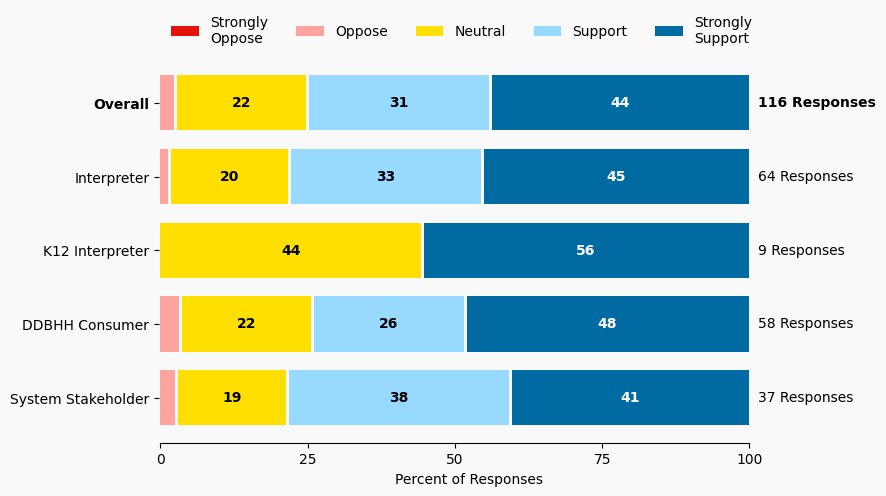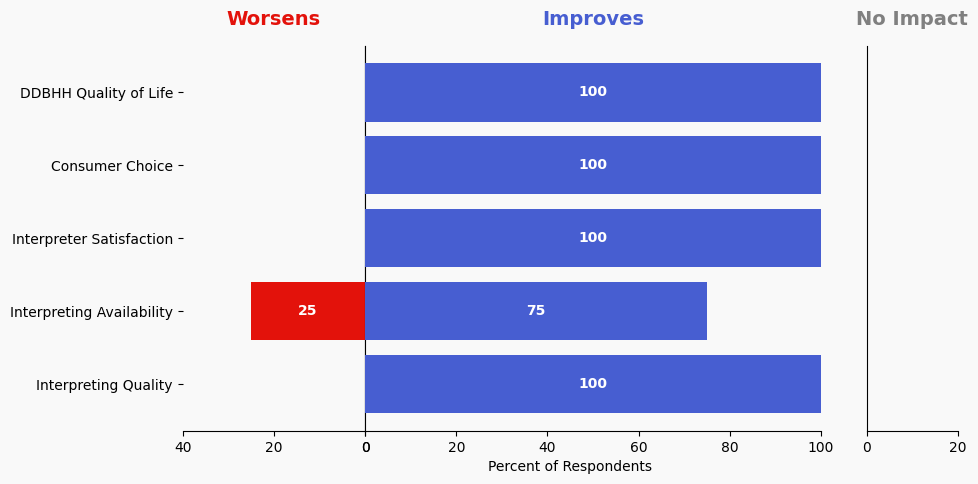72 Prevent Repetitive Motion Injury and Burnout by Hiring Team Interpreters in K12 Settings
Issue: K12 educational interpreters are not regularly provided team interpreters, thus leading to burnout and repetitive motion injuries.
Proposed Solution: MDE to advocate for school districts hiring additional “float” interpreters who can provide support and relief by teaming as needed with regular staff interpreters.
Expected outcome: Higher retention of educational interpreters
Who is impacted: Educational interpreters
Timeline: 6 months

Summary of Support Image Description
The stacked bar charts show how respondents rated their level of support and the total number of responses. The percentage for the five support levels is shown from left to right: Strongly Oppose (Dark Red), Oppose (Light Red), Neutral (Yellow), Support (Light Blue), and Strongly Support (Dark Blue).
Respondents may identify with multiple subgroups. The overall level of support is:
Overall
Strongly Oppose: 0%
Oppose: 3%
Neutral: 22%
Support: 31%
Strongly Support: 44%
Click to see the detailed image description for each subgroup.
Interpreter
Strongly Oppose: 0%
Oppose: 2%
Neutral: 20%
Support: 33%
Strongly Support: 45%
K12 Interpreter
Strongly Oppose: 0%
Oppose: 0%
Neutral: 44%
Support: 0%
Strongly Support: 56%
DDBHH Consumer
Strongly Oppose: 0%
Oppose: 3%
Neutral: 22%
Support: 26%
Strongly Support: 48%
System Stakeholder
Strongly Oppose: 0%
Oppose: 3%
Neutral: 19%
Support: 38%
Strongly Support: 41%
Overview of Respondents Opting for In-Depth Solution Analysis
After indicating their support level, 2% of the 116 respondents opted in to further assess whether the solution would worsen or improve on five metrics. Of the opt-in reviewers (3 respondents), 100% supported the solution, 0% were neutral on the solution, and 0% opposed the solution.
The remaining 113 respondents did not opt in to further assess the solution. Of these people, 74% support the solution, 23% were neutral on the solution, and 2% opposed the solution.
Reviewer Evaluation of Solution Effectiveness

Solution Effectiveness Image Description
The stacked bar charts show how respondents assessed the effectiveness of this solution based on five metrics. For each metric, the percentage of respondents is shown from left to right: Worsens (Red), Improves (Blue), No Impact (Gray).
DDBHH Quality of Life
Makes It Worse 0%
Makes It Better 100%
No Impact 0%
Interpreter Satisfaction
Makes It Worse 0%
Makes It Better 100%
No Impact 0%
Consumer Choice
Makes It Worse 0%
Makes It Better 100%
No Impact 0%
Interpreting Availability
Makes It Worse 25%
Makes It Better 75%
No Impact 0%
Interpreting Quality
Makes It Worse 0%
Makes It Better 100%
No Impact 0%
Reviewer Feedback and Insights
Interpreter
Comments from Interpreters broadly express support with some questions. One comment expresses curiosity about how a “float” position might function in education, emphasizing that teaming involves more than just occasional support, such as sharing prep time and actively working together. Another comment supports retention and burnout prevention but questions the necessity and cost-effectiveness of team interpreters in K12 classrooms, noting built-in breaks and manageable content. Another comment highlights the benefit of working with more experienced interpreters in a team, stating that lack of teams is a reason for avoiding K12 interpreting.
Deaf, DeafBlind, Hard of Hearing
No comments were submitted.
System Stakeholder
No comments were submitted.
PREVIOUS SOLUTION
Issue: School districts operate differently when hiring K12 interpreters, resulting in a lack of standards and quality control.
NEXT SOLUTION
73 Interpreter Training Programs (ITPs) Include K12 Education Components in Curricula
Issue: There appears to be inconsistent curricula about K12 educational interpreting across Minnesota’s ITPs. K12 educational interpreters wish for more formal education about EIPA and IEPs specifically.
Leave a Reply